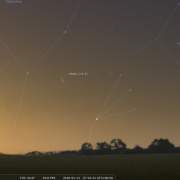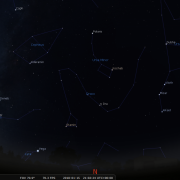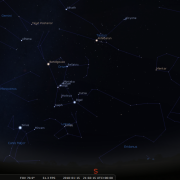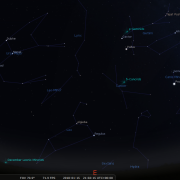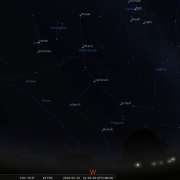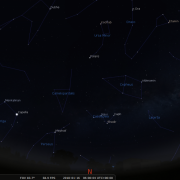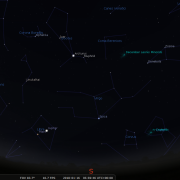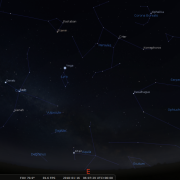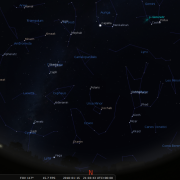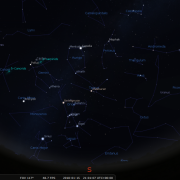In this month's Sky Notes:
- Planetary Skylights
- Earth Reaches Perihelion
- Supermoon and Blue Moon
- New Year Meteors
- January 2018 Sky Charts
Planetary Skylights
The start of a new year sees the darkest mornings with sunrise not occurring until well after 20:00h. Normally you would moan (and you still might) about the low lumens, but if skies are clear for these January mornings the unfolding planetary action across in the south and southeast may tempt you out without the need to rise during the middle of the night to observe it! Jupiter, Mars, Mercury and Saturn are all to be located during the month, with some particularly close encounters to enjoy.
Evening
 To start off, look for brilliant Jupiter low to the south around 07:00h during the first week of January – it will be the brightest object on show.
To start off, look for brilliant Jupiter low to the south around 07:00h during the first week of January – it will be the brightest object on show.

 The orange ‘star’ to the right of Jupiter is Mars, which edges ever closer to Jupiter during this period. By the 6th and 7th the pair look exceedingly close to the naked eye. Viewed through a telescope at low power you should be able to frame both in the same field of view. The pair then go their separate ways, Jupiter westwards, with Mars sliding down toward the ‘other’ conspicuous and real star, Antares in Scorpius. On the 11th a crescent Moon lies above both planets. View around 07:00h.
The orange ‘star’ to the right of Jupiter is Mars, which edges ever closer to Jupiter during this period. By the 6th and 7th the pair look exceedingly close to the naked eye. Viewed through a telescope at low power you should be able to frame both in the same field of view. The pair then go their separate ways, Jupiter westwards, with Mars sliding down toward the ‘other’ conspicuous and real star, Antares in Scorpius. On the 11th a crescent Moon lies above both planets. View around 07:00h.
 Also during the first week, look down lower left of Jupiter of Mars where just above the SE horizon you will, with luck and location, spot elusive Mercury. Luck, because the horizon will have to be clear of cloud, and location for similar reasons – ie unobstructed, no buildings or trees etc. Mercury should be quite conspicuous to the naked eye, but use binoculars if you cannot initially track it down. View around 07:30h.
Also during the first week, look down lower left of Jupiter of Mars where just above the SE horizon you will, with luck and location, spot elusive Mercury. Luck, because the horizon will have to be clear of cloud, and location for similar reasons – ie unobstructed, no buildings or trees etc. Mercury should be quite conspicuous to the naked eye, but use binoculars if you cannot initially track it down. View around 07:30h.
 Then, between the 10th and 14th, look for Saturn emerging into the dawn sky, sliding up and right of Mercury. The two are closest on the 13th with Saturn just above Mercury. Good hunting.
Then, between the 10th and 14th, look for Saturn emerging into the dawn sky, sliding up and right of Mercury. The two are closest on the 13th with Saturn just above Mercury. Good hunting.
Earth Reaches Perihelion
Finally, on Jan 3rd Earth reaches Perihelion (closest to the Sun in its orbit) some 91.4 million miles or 147 million km distant. It’s the tilt of the Earth’s axis which gives rise to the colder, dark, short winter days, not the distance from the Sun, which many people still assume is the reason.
Supermoon and Blue Moon
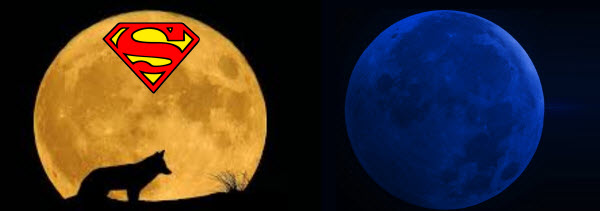
January sees two full moons; the first on the 2nd being close to Lunar perigee will no doubt be called a ‘supermoon’ by the media as it will appear a tad larger. The second full moon on the 31st is known as a ‘blue moon’ – the second full moon in a month. It will not look blue, and as there is another ‘blue moon’ in March, it is not that rare this year either.
New Year Meteors

The year starts with one of the more prolific meteor showers, the Quadrantids, active between Jan 1- 6th. The short lived shower peak normally falls over the night of 3rd/4th, with best rates witnessed in the small hours; 02:00-04:00h. Peak zenith hourly rates can reach 100 plus per hour, but actual observed rates by an individual will be substantially less, more so this year as a near full moon will severely curtail numbers. You should still spot a few Quadrantids however, which are often, fairly swift, producing occasional yellow-green fireballs.
Quadrantids appear to radiate from the now defunct constellation of Quadrans Muralis, which was removed from sky charts in 1922, but used to lie at the junction between Hercules, Bootes and Ursa Major. This position in the sky is located low to the N at the time of the peak, so do not concentrate on this aspect if viewing.
December's Geminids Report
For once clear skies coincided with the peak of the Geminid meteor shower, much appreciated by all meteor observers. John Lamb spent several hours armed with camera in the Upgang ravine (golf club) and reported seeing over 50.
Mark, (who spent the first half of the night at work) could only manage 15 minutes around 02:40h watching from home out of the patio doors - facing north. He recorded seven, but both saw a particularly bright Geminid streak through Cassiopeia at approximately 02:45h – perhaps mag -3, blue white in hue.
January 2018 Sky Charts
|
Looking North
Mid-January - 21:00h |
Looking South |
|
Looking East
Mid-January - 21:00h |
Looking West
Mid-January - 21:00h |
| Looking North (morning) Mid-January - 06:00h |
Looking South (morning) Mid-January - 06:00h |
| Looking East (morning) Mid-January - 06:00h |
Looking West (morning) Mid-January - 06:00h |
| Northern Aspect Mid-January - 21:00h |
Southern Aspect Mid-January - 21:00h |
Additional Image Credits:
- Planets and Comets where not otherwise mentioned: NASA
- Sky Charts: Stellarium Software
- Log in to post comments


